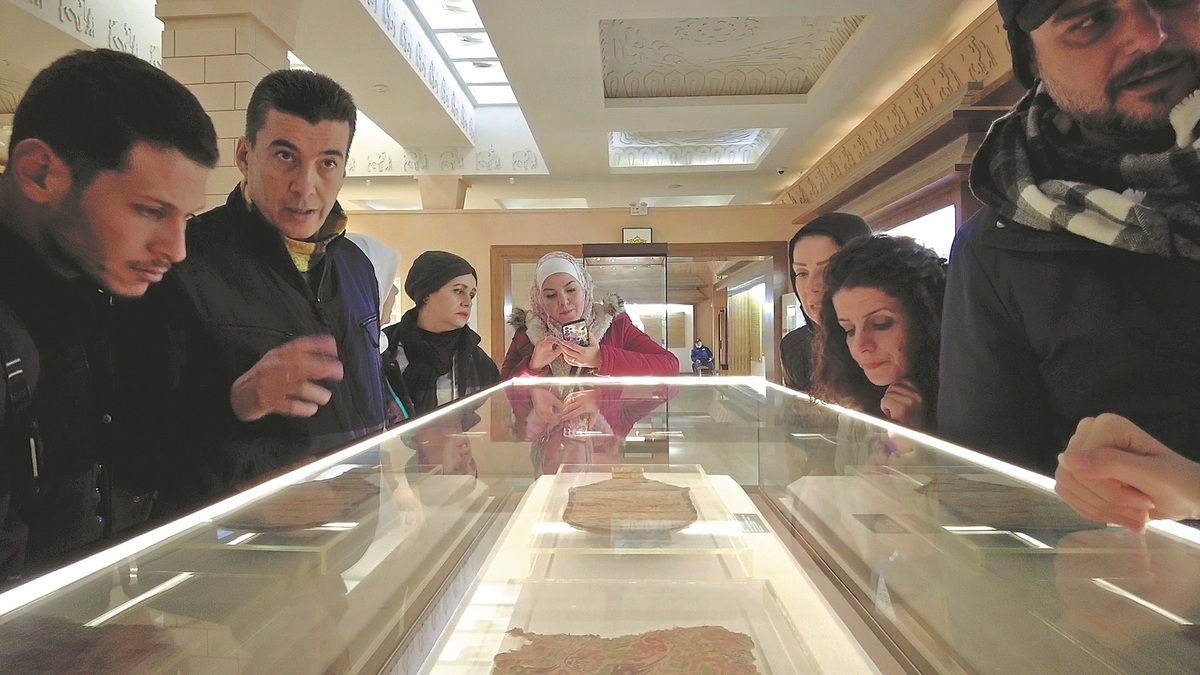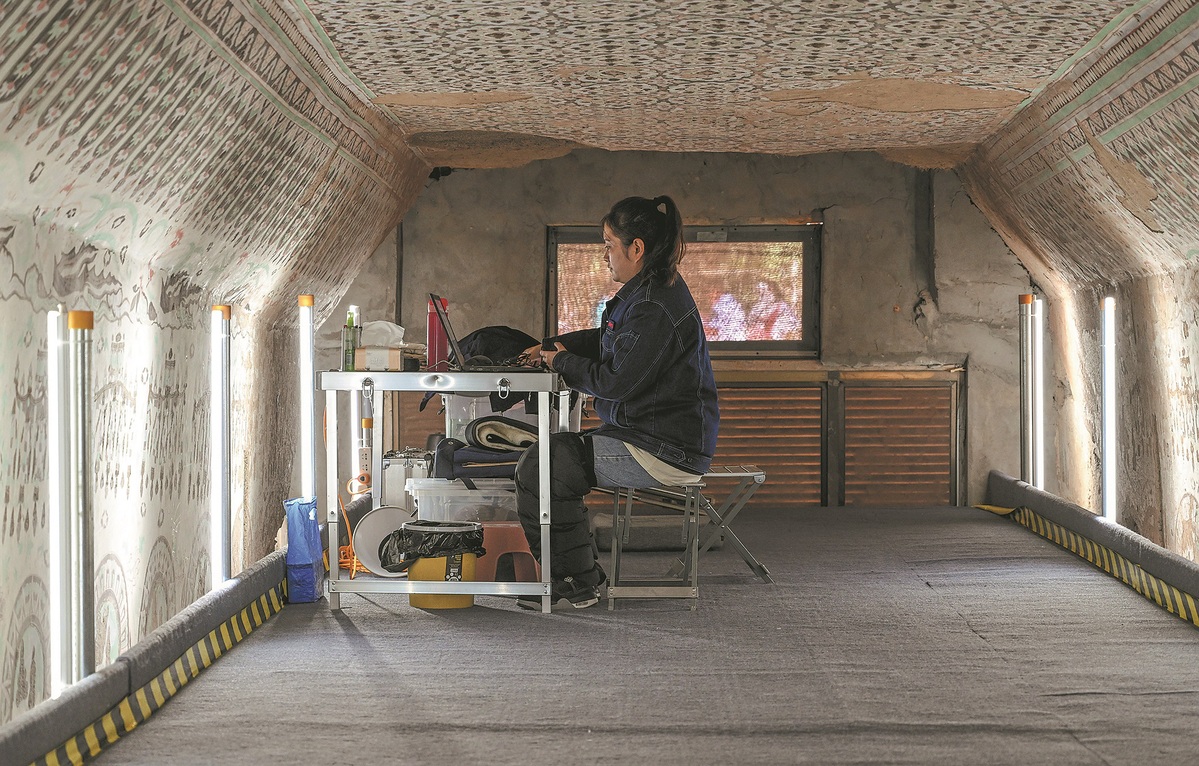Mogao Caves' preservation inspires Syrian experts
From:China DailyAuthor: 2024-02-21 14:48

Syrian archaeologist Jihad Abu Kahla captures the intricate patterns of an unearthed brick in Dunhuang, Gansu province. [YAO YUXIN/CHINA DAILY]
Hidar Yousef initially aspired to be a tour guide. However, he now finds himself acting as a guardian of Syria's cultural heritage, working at the Directorate-General of Antiquities and Museums in the capital Damascus.
The country's civil war dramatically changed the course of his life. After the conflict erupted in 2011, tourists vanished, the tourism industry collapsed, and cultural relics became targets for bombing, theft, illegal excavations and smuggling.
"It's kind of an ironic story," Yousef said. "I wanted to introduce (artifacts). Now I am rescuing (them)."
The conflict altered almost everything in the 31-year-old's life. Born into a Syrian middle-class family, Yousef once enjoyed the trappings of affluence, with his family having four apartments and three cars. However, after the war his entire family is now forced to live in a single dwelling.
His wedding plans have been repeatedly delayed as he cannot afford the $200 engagement ring. As an archaeologist with a doctorate, he scrapes by on a meager $15 a month, and like nearly all Syrians he juggles at least two jobs just to make ends meet.
Day-to-day survival is a challenge for most Syrians, with the preservation of the country's cultural heritage low on most people's list of priorities, he said.
Yousef shared his story during a study tour of the Mogao Caves in Dunhuang, Gansu province, in early November. He was part of a delegation of 24 Syrian cultural scholars and officials, seeking to learn from China's expertise in cultural heritage preservation.
"All the time we viewed European experience as the best," he said. "But one or two years ago, we started to look to the East," he said, adding that they chose China to find out what was going on in the area of cultural heritage preservation.
"We were actually surprised, China is way better," he said.
Caves inspire visitors
When it came to China's antiquities and cultural heritage, Ibrahim Kherbek, director of the DGAM's Lattakia Antiquities Department on Syria's Mediterranean coast, only knew about the Great Wall before he visited the country. He said he had never heard of Dunhuang.
However, after visiting the Mogao Caves and attending lectures by experts from the Dunhuang Academy, he expressed his astonishment at China's high level of cultural heritage preservation.
Kherbek has worked in the field of cultural heritage for over 30 years and interacts with artifacts daily. "Cultural relics have become a part of my life," he said.
The destruction and obliteration of Syrian cultural heritage by war and terrorism is heartbreaking, Kherbek said. All six UNESCO World Heritage Sites in Syria have been put on the endangered list, including the Ancient City of Damascus, which dates back to the third millennium BC and is considered one of the oldest continually inhabited cities in the world.
In 2018, seven years after the outbreak of war, Syria reopened the National Museum of Damascus and showcased artifacts that had been carefully hidden away during the conflict. "Only by eliminating war can the foundation of peace and stability be laid for cultural heritage to continue to exist," Kherbek said.
China has faced similar hardships in recent centuries when it comes to cultural preservation, enduring the ravages of imperialism and war. Countless Chinese cultural artifacts were destroyed, plundered and taken overseas, with many still unrecovered.
Yu Zongren, director of the Institute of Conservation at Dunhuang Academy, said it's hard to imagine that the well-preserved Mogao Caves were abandoned for over four centuries.
Some murals were darkened by oil lamps used for worship and cooking smoke, some Buddha statues were looted, and the lower caves were blocked by sand drifts. In the 1950s, with no electricity or cars, sand clearance relied on ox- and horse-drawn carts.
Today, the protection of the Mogao Caves involves meticulous efforts. Temperature, humidity, and carbon dioxide levels are monitored in real-time, and kiln-fired tiles have replaced cement bricks on the floor to allow for better ventilation.
To preserve the environment and microclimate, a temporary parking lot was removed by the National Cultural Heritage Administration to restore the area to its original state.
The UNESCO World Heritage Site is also embracing technology, and digitizing images of Buddha statues and murals to be shown in places outside Dunhuang.
"The prosperity or decline of civilization is closely intertwined with the stability and strength of a nation," Yu said.

Syrian archaeologists meticulously examine and discuss a fragment of silk fabric excavated from Dunhuang. [YAO YUXIN/CHINA DAILY]
Impact of war
Beyond ruining numerous cultural artifacts, the war also altered the development priorities of Syria, said Jihad Abu Kahla, director of the Damascus Countryside Antiquities Department at the DGAM.
Reviving the economy, securing people's livelihoods, and maintaining stability have taken precedence, making cultural heritage preservation less of a priority, Abu Kahla said.
Sanctions imposed by the United States in June 2020 have also added formidable obstacles to cultural restoration efforts in Syria after the war, according to Ahmad Dali, director of the digitalization department at the DGAM.
Dali said the US' restrictions on exporting materials and equipment necessary for artifact restoration to Syria, coupled with a shortage of skilled professionals and the economic burden of cultural preservation, have forced many restoration projects to be shelved.
Nevertheless, Dali's department is working on digitizing documentation on Syrian cultural artifacts and carrying out emergency repairs to the best of their abilities.
"Construction of a national identity is achieved through the inheritance and transmission of cultural heritage from one generation to the next," Abu Kahla said.
"Preserving cultural artifacts is tantamount to safeguarding the future of a nation."

An archaeologist organizes data collected for the protection of the murals in a cave of the Mogao Caves in Dunhuang. [LI HE/XINHUA]
Exchange and cooperation
In 1999, the Mogao Caves unearthed four pages of biblical psalms written in Syriac — an Aramaic dialect used as the literary and liturgical language of the ancient Syrian Christian churches — believed to be from the Yuan Dynasty (1271-1368).
During the Yuan Dynasty, Gansu was a center for Nestorianism, a branch of Eastern Christianity that was prevalent in Central Asia. Dunhuang, in particular, witnessed multiple interactions with Western Christians, including notable figures like the Venetian explorer Marco Polo.
The discovery of the psalms underscored the long-standing cultural exchanges between the two countries.
Hala Emad, a senior official of Syria's Planning and International Cooperation Commission, said due to the prolonged conflict, cooperation between China and Syria was limited and primarily confined to humanitarian aid.
However, there has been a shift in recent years, especially after Syria became part of the Belt and Road Initiative last year, she said.
In ancient times, both nations were closely connected through the Silk Road. "Today, we have the opportunity to further extend our friendship through the new Silk Road of the BRI," Abu Kahla said.
China and Syria face common challenges in cultural heritage preservation, such as intentional damage, and mitigating the impact of damaging natural conditions.
Yu Jiannan, Party secretary of the Central Academy of Culture and Tourism Administration, said fostering exchanges and collaboration among cultural heritage professionals from both countries is essential.
"The potential for cooperation in the field of cultural heritage preservation between China and Syria is vast and promising," Yu said.
Expertise shared
After approximately 80 years of research, the Dunhuang Academy has amassed significant expertise in mural and sculpture protection. Before the COVID-19 pandemic disrupted cooperation, more than 200 Chinese teams visited Central Asia and conducted on-site inspections of cultural sites and devised cultural heritage assistance projects.
"If any country requires assistance, we are more than willing to undertake such tasks," said Su Bomin, head of the Dunhuang Academy.
During the cultural exchange, Dali, director of the digitalization department at the DGAM, detailed the current state of cultural heritage preservation in Syria to experts and officials from both countries.
The contrasting images of heritage sites before and after the war brought many of the Syrian representatives to tears. Once majestic buildings and traditional markets had been reduced to ruins. During the five-day trip to Dunhuang, it was the rawest glimpse of the pain wrought by the war in Syria.
Yara Shartouh, director of tourism in Hama, said Syrians dislike war, yearn for peace and always approach life with hope and optimism. No matter what happens, they manage to maintain a positive outlook.
"This is the essence of our culture," she said.
Edit:董麗娜
The copyright of the article and the picture belongs to the original author. If there is any infringement, please contact to delete it